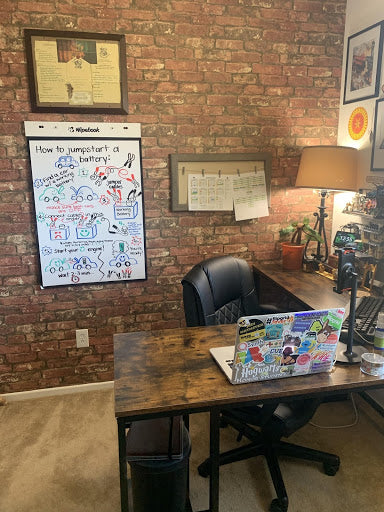The Benefits of Sketchnote
Alexa Lepp, Vasquez High School, Acton-Agua Dulce Unified School District
March 13th, 2020. A date many educators, like me, will probably remember for the rest of our lives. It was the last day I was in person, teaching in my classroom with my students. Distance Learning has been a vast shift for so many teachers, students, and parents. Luckily, we live in the Digital Age, so we have the tools necessary to connect virtually still. This, though, does create a new kind of problem: how can we design learning experiences for our students that are equitable, engaging, and effective? Better yet, how can I do that from afar and work through technology screen fatigue? While I love technology (my Ma.Ed. in Educational Technology), I also know that balance is key. Sketchnoting is a notetaking method I love using because it creates that balance we all need and promotes creativity as a comprehension strategy. One of my favorite tools to use for sketchnoting: Wipebook Flipcharts!
Why Sketchnotes?
In learning, there is a correlation between sense and meaning and learning and retention. According to Sousa (2017), “Brain scans and other studies have shown that when new learning is readily comprehensible (sense) and can be connected to past experiences (meaning), there is substantially more cerebral activity followed by dramatically improved retention” (p. 124). When students are learning, it can go to working memory; however, it doesn’t mean it will go to long term storage. After the lesson, it can disappear and not mean anything relevant. A goal within teaching is for students to retain information to recall it later, and hopefully, build upon it.Sketchnoting is a brain-based learning practice to note-taking that helps retention. Our brains are incredibly visual!
 |
Sketchnoting can be used for vocabulary, comprehension, and notetaking. It helps with engagement, focus, comprehension, and memory! I can personally attest to this: Whenever I attend a conference, listen to a podcast, or attend a workshop, I sketchnote. It’s a method that can be used for all learners, no matter their learning style. Also, you don’t need to identify as an artist or have incredible drawing skills to sketchnote! It’s more of a visual way to represent ideas. If you can draw shapes, lines, and arrows, you can sketchnote!
 |
Some of my favorite activities involve students sketchnoting their understanding of informative information. Students can use the Wipebook Flipchart to sketchnote information coming from articles, podcasts, Ted Talks, novel studies, and more! This can be done individually or collaboratively. The point is to take verbal information and make it visual!
Reusable Canvas
Before I had a Wipebook Flipchart, I used the large notepads when I asked students to brainstorm ideas together. The problem: I couldn't save them. I wasted a lot of paper. Using the Wipebook Flipcharts, though, students have a reusable surface. They’re also incredibly easy to clean since they are like a mobile whiteboard! Students can draw and edit their visual representations as they sketchnote. Once they are done with their notes, they can wipe them clean and reuse the same flipchart!
 |
Each Wipebook comes with ten flipcharts, which are two-sided. One side has a grid, and the other side is a blank canvas. I love using the side with the grids for sketchnotes and graphic organizers because it helps with spacing! Since the Flipcharts are so large, it works perfectly for collaborative work!
Want students to turn in their sketchnotes digitally? Well, there is an app for that! AND it syncs to Google Drive, Dropbox, Evernote, Microsoft OneDrive, or email. I work in a Google District, so it links to Google Drive is perfect! Since they have an app, students can take a picture of their sketchnotes, save it to their Drive, share it with their classmates (or to Google Classroom), and reuse the Wipebook. Win-win!
 |
Since I now work from home, I’m using my Wipebook Flipchart as my whiteboard and sketchnoting platform. I use it for my weekly video announcements, flipped classroom videos, and I model sketchnoting using my Wipebook. Upon our return to campus, I will be using the Wipebook Flipcharts to bring back those collaborative spaces for students to represent information and create their version of art visually!
Getting Started with Sketchnotes
Want to introduce your students to sketchnoting while on distance learning? Here’s how I would do it!
- Get your sketchnoting tool set up. In this case, I’ll be using the Wipebook because it’s easy to see and large enough so that my students can view what I am doing. Students can also use a Wipebook or pencil and paper.
- Explain what sketchnoting is. I like to use this video as an introduction: Sketchnote Basics by Nichole Carter
- Practice some sketchnotes together! The point is to get them engaged and introduce them to this idea of sketchnotes. Sylvia Duckworth has some incredible resources teachers can use as a reference! Check out this site to learn more.
- After the introduction, begin sketchnoting! It can be freestyle where students offer suggestions of what to sketchnote or something you do together as a class (e.g., watch a Ted Talk, listen to a podcast, etc.). You’ll find that your students will love the creative outlet, have better retention of learning, and be engaged through the process!
Want some more resources on Sketchnoting? Here are some of my favorites!
- Verbal to Visual:
- Sketchnoting In The Classroom with Doug Neill
- Google's MASSIVE Archive of Simple Drawings with Doug Neill
- Verbal to Visual Youtube Library
- The Sketchnote Podcast: Season 1 Re-Released
- Tips for getting started sketchnoting with students
You may also like:
- A break from virtual learning with VNPS
- Ways to fill our bucket
- Closing the Distance with Thesis Gallery Walks
